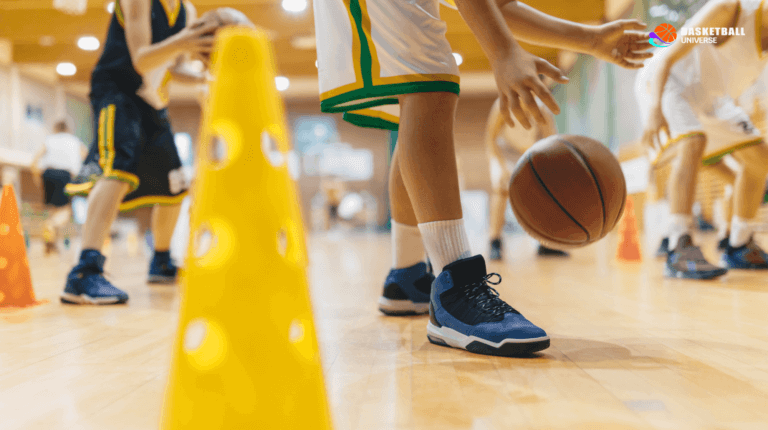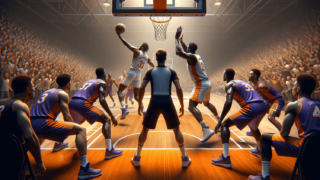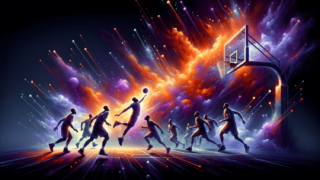
What Is Ejection in Basketball?
Written by: Basketball Universe
Last updated:

Imagine this: The stadium roars with excitement, and tension builds on the court as the game reaches its crescendo. Then, suddenly, a player becomes embroiled in drama, leading to an unexpected turn of events – an ejection. For basketball enthusiasts, this might sound like a familiar scene, but for those still learning the ins and outs of the game, what is an ejection in basketball? In this blog post, we will dissect this captivating yet contentious aspect of the sport, exploring its causes, consequences, and impact on players and teams alike. Strap yourselves in for a slam dunk of knowledge as we break down the complexities of ejection in basketball!
What Is Ejection in Basketball?
Ejection in basketball refers to the removal of a player, coach, or other team personnel from the game due to unsportsmanlike conduct, excessive rule violations, or any action that compromises the integrity of the sport. Ejections typically occur after receiving several technical fouls or a single flagrant foul, depending on the severity of the infraction. Once ejected, the individual must leave the court area and stay out of sight for the remainder of the game.
Understanding Technical Fouls
Before diving into the concept of ejection in basketball, it’s essential to understand technical fouls. A technical foul is a violation of the game’s rules that doesn’t involve physical contact between opposing players. Technical fouls are called for unsportsmanlike conduct, such as arguing with an official, taunting an opponent, or getting involved in an unnecessary altercation. While these infractions may not directly affect gameplay, they disrupt the game’s flow and can escalate tensions on the court.
Categories of Technical Fouls
Technical fouls can be broadly divided into two categories:
- Player or Bench Technical Fouls: These are called against individual players or bench personnel for various offenses, such as disputing a call, inappropriate language, or gestures during a game.
- Team Technical Fouls: These fouls involve the entire team and are usually imposed for administrative violations, such as failing to submit a proper roster, using illegal equipment, or delaying the game’s progress.
Flagrant Fouls and Ejections
A flagrant foul is a severe offense in basketball involving unnecessary and excessive contact against an opponent. This type of foul involves intentional or reckless actions that can jeopardize a player’s safety. Due to their seriousness, flagrant fouls often result in an immediate ejection from the game.
Types of Flagrant Fouls
The NBA, NCAA, and FIBA recognize two different types of flagrant fouls:
- Flagrant Foul 1: Unnecessary contact against an opponent. This type of foul can lead to the ejection of a player if they commit multiple Flagrant 1 fouls in a game.
- Flagrant Foul 2: Unnecessary and excessive contact against an opponent. This category includes intentionally striking, tripping, or otherwise endangering a player, resulting in an automatic ejection from the game.
It’s worth noting that the definitions and enforcement of flagrant fouls can vary slightly between leagues and competitions.
Ejection Triggers in Basketball
Players, coaches, and team personnel can be ejected from a basketball game under specific circumstances, such as accumulating an excessive number of technical fouls or committing flagrant fouls. Here, we’ll explore the most common triggers for ejection in the sport.
Multiple Technical Fouls
In many basketball leagues, including the NBA and NCAA, a player is automatically ejected for receiving two technical fouls in a single game. However, other leagues, like FIBA, require a player to accumulate three technical fouls before ejection. It’s important to keep in mind that these limits apply to individual players, not the team as a whole. Coaches can also be ejected for receiving multiple technical fouls, although the specific number may differ depending on the league or competition rules.
Flagrant 2 Fouls
As mentioned earlier, committing a Flagrant 2 foul leads to an automatic ejection. Referees have the discretion to review and categorize fouls, and even upgrade a Flagrant 1 to a Flagrant 2, depending on their assessment of the severity of the contact and the intent of the player responsible.
Fighting and Physical Altercations
Physical altercations, such as fighting or engaging in other aggressive behavior, are not tolerated in basketball, and engaging in such conduct often leads to immediate ejection from the game. Depending on the severity, the league can also impose additional penalties, such as fines, suspensions, or both, for any player involved in a fight or other violent incident.
Ejections and Their Impact on Teams
When a player is ejected from a basketball game, it can have significant consequences for their team, both in the short term and in subsequent matches. Let’s examine some of these potential impacts.
Immediate Impact: Loss of a Key Player
Ejections often lead to the loss of a crucial player crucial to the team’s performance. Their absence may substantially weaken a team’s chances of winning, especially if the ejected player is a star athlete or has a pivotal role within the team.
Impacts on Team Morale and Chemistry
Ejections can hurt not only the team’s abilities on the court but also their morale and chemistry. Losing a teammate may cause resentment, frustration, or increased pressure on the remaining players. This emotional fallout can lead to internal strife and disrupt the team’s ability to work together effectively.
Penalties Following an Ejection
Ejections can result in additional penalties, such as fines or suspensions, which can further affect a team’s performance in subsequent games. Suspensions, in particular, can force coaches to rearrange their rosters, which may disrupt the team’s game plan and rhythm during a critical part of the season.
How to Avoid Ejections in Basketball
Avoiding ejections in basketball is crucial for both the individual player and the entire team. Here are some helpful tips to prevent ejections and maintain a positive atmosphere on the basketball court.
Build Emotional Intelligence and Self-control
Practicing self-control and managing one’s emotions during stressful situations can significantly reduce the risk of engaging in unsportsmanlike behaviors that could lead to an ejection. Regularly practicing mindfulness and relaxing techniques can help players better manage their emotions and avoid letting tensions escalate on the court.
Respect Officials and Opponents
Demonstrating sportsmanship is key to avoiding ejections. Make it a priority to show respect toward officials, even when you disagree with their decisions. Maintaining a cordial and professional relationship with opponents can also prevent unnecessary conflicts that could lead to an ejection.
Know the Rules and Penalties
Understanding the rules of basketball and the penalties associated with various violations can help players avoid behaviors that may lead to ejections. Familiarizing yourself with the specific regulations of the league you’re playing in will give you a better understanding of what’s acceptable and what’s not during a game.
Significance of Ejection Rules in Basketball
Ejection rules are essential in basketball to maintain a safe, respectful, and sportsmanlike environment for all players, coaches, and officials. They serve as a deterrent against unsportsmanlike conduct and protect the integrity of the game. Ensuring that players understand and adhere to these rules helps minimize disruptions, allows matches to proceed smoothly, and upholds the spirit of competition at every level of the sport.
Ejections: Notable Instances and Their Consequences
In the world of basketball, ejections have occasionally generated memorable moments and sparked heated discussions. Here are a few notable ejections that shook the basketball community and led to significant consequences.
Ron Artest and the Malice at the Palace
One of the most infamous incidents in NBA history occurred on November 19, 2004, during a game between the Indiana Pacers and the Detroit Pistons. Forward Ron Artest (now known as Metta Sandiford-Artest) was involved in an altercation with several Pistons players. When a fan threw a drink at him, Artest retaliated by charging into the stands, igniting a massive brawl involving players and fans alike. Artest, along with numerous other players, was ejected from the game, and he ultimately received a season-long suspension for his involvement in the incident.
Draymond Green’s Suspension in the 2016 NBA Finals
Another high-profile ejection occurred during Game 4 of the 2016 NBA Finals between the Cleveland Cavaliers and the Golden State Warriors. Forward Draymond Green was assessed a flagrant foul for making contact with LeBron James’ groin area, leading to a one-game suspension when it was determined that he had accumulated a series of flagrant fouls throughout the playoffs. Green’s absence in Game 5 played a significant role in the Cavaliers’ historic comeback, as they overcame a 3-1 deficit to win their first NBA championship.
The Ejection of Tim Duncan for Laughing
One of the strangest ejections in NBA history happened on April 15, 2007, when San Antonio Spurs forward Tim Duncan was ejected from a game against the Dallas Mavericks for laughing on the bench. Referee Joey Crawford, who issued the ejection, believed Duncan was laughing at him and decided to penalize him with a second technical foul. In light of the incident, the NBA suspended Crawford, citing inappropriate conduct and poor game management.
Understanding the Ejection Review Process
Although referees are primarily responsible for assessing fouls and ejecting players, most basketball leagues have a review process in place to examine controversial ejection decisions. This process helps ensure that appropriate penalties are issued and that fouls are accurately categorized.
Instant Replay Review
Referees have access to instant replays during the game to review specific calls, including flagrant and technical fouls. These replays allow officials to confirm or upgrade fouls, and they can even reverse decisions if the video evidence demonstrates that the initial call was incorrect.
League Review and Penalties
Once a game has concluded, league officials may review ejections and other incidents to determine whether further action, such as fines or suspensions, is necessary. A post-game review can also result in the rescinding of fouls, allowing players to avoid suspension-triggering thresholds in subsequent games.
Maintaining a Positive Basketball Culture
In conclusion, understanding the ejection rules and avoiding unsportsmanlike conduct is crucial for maintaining a healthy and respectful atmosphere on the basketball court. By knowing the rules, promoting fair play, and fostering emotional intelligence, players, coaches, and teams can uphold the spirit of basketball – a sport beloved by millions around the globe.
Frequently Asked Questions (FAQ)
In this section, we’ve compiled a list of common questions and answers about ejections in basketball, providing insights into the rules, situations, and impacts of such occurrences. These FAQs will further expand your knowledge and understanding of this important aspect of the game.
1. Can someone other than the player be ejected from a basketball game?
Yes, in addition to players, coaches and other team personnel can also be ejected from a basketball game for misconduct, accumulating technical fouls, or engaging in prohibited behaviors.
2. What happens if a coach gets ejected?
If a coach is ejected from a game, an assistant coach or another designated staff member assumes their responsibilities for the remainder of the match.
3. How is an ejection different from a disqualification in basketball?
An ejection is a result of unsportsmanlike conduct, such as accumulating multiple technical fouls or committing flagrant fouls, while a disqualification occurs when a player accumulates a certain number of personal fouls (usually six) during a game. An ejected player must leave the court area, while a disqualified player can stay on the bench.
4. Do ejected players face any additional penalties once removed from the game?
Ejected players may face additional penalties, such as fines or suspensions, depending on the circumstances and severity of their actions. League officials determine these penalties after reviewing the incident.
5. How do officials determine if a foul is flagrant?
Officials examine the severity, intention, and consequences of the contact when determining if a foul is flagrant. They consider factors like reckless or unnecessary force, potential for injury, and the player’s history of similar offenses.
6. Can ejected players be replaced during the game?
Yes, ejected players can be replaced by a teammate who is eligible to play. However, the team’s overall roster size remains the same, leaving them one player short for the remainder of the game.
7. How do ejections affect a team’s overall performance?
Ejections can result in the loss of a key player, negatively impacting the team’s performance, morale, and chemistry. Additional penalties like suspensions can also affect a team’s success in subsequent games.
8. Can an ejection be overturned during a game?
Ejections are typically non-reversible during a game as they involve serious offenses. However, referees can review and potentially downgrade fouls that led to an ejection if they determine the severity of the contact was incorrectly assessed.
9. Do ejections count against a player’s season statistics?
Ejections do not directly impact a player’s statistical records but are noted as part of their disciplinary history for the season.
10. Can a player be ejected for accumulating too many personal fouls?
No, a player cannot be ejected for accumulating personal fouls. However, they can be disqualified due to reaching the foul limit (usually six) during a game.
11. How does a player avoid an ejection?
A player can avoid an ejection by practicing self-control, knowing the rules and penalties, and demonstrating respect towards officials and opponents.
12. Are there any famous instances of ejections that impacted the outcome of a game or series?
Yes, one notable example is Draymond Green’s suspension in Game 5 of the 2016 NBA Finals, which contributed to the Golden State Warriors losing the championship to the Cleveland Cavaliers.
13. How do various basketball leagues handle ejections differently?
Different leagues may have varying rules and parameters for fouls and ejections, such as the number of technical fouls required for an ejection, as well as the specific definitions and consequences of flagrant fouls.
Featured Posts
- No pillar pages found.





